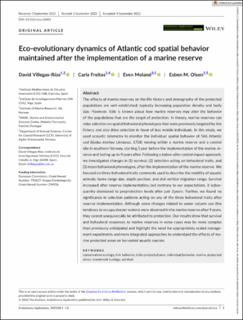| dc.description.abstract | The effects of marine reserves on the life history and demography of the protected populations are well-established, typically increasing population density and body size. However, little is known about how marine reserves may alter the behavior of the populations that are the target of protection. In theory, marine reserves can relax selection on spatial behavioral phenotypes that were previously targeted by the fishery and also drive selection in favor of less mobile individuals. In this study, we used acoustic telemetry to monitor the individual spatial behavior of 566 Atlantic cod (Gadus morhua Linnaeus, 1758) moving within a marine reserve and a control site in southern Norway, starting 1 year before the implementation of the marine reserve and lasting up to 9 years after. Following a before-after-control-impact approach, we investigated changes in (1) survival, (2) selection acting on behavioral traits, and (3) mean behavioral phenotypes, after the implementation of the marine reserve. We focused on three behavioral traits commonly used to describe the mobility of aquatic animals: home range size, depth position, and diel vertical migration range. Survival increased after reserve implementation, but contrary to our expectations, it subsequently decreased to preprotection levels after just 3 years. Further, we found no significance in selection patterns acting on any of the three behavioral traits after reserve implementation. Although some changes related to water column use (the tendency to occupy deeper waters) were observed in the marine reserve after 9 years, they cannot unequivocally be attributed to protection. Our results show that survival and behavioral responses to marine reserves in some cases may be more complex than previously anticipated and highlight the need for appropriately scaled management experiments and more integrated approaches to understand the effects of marine protected areas on harvested aquatic species. | en_US |
